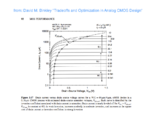iexplorer
Member level 3
Does anyone know if the subthreshold n factor in (I=It exp((VGS-VTH)/(nVT))) has large variation with process corner and temperature? And also is the n factor the same in parasitic BJT current equation? Thanks!
Follow along with the video below to see how to install our site as a web app on your home screen.
Note: This feature may not be available in some browsers.
I have simulated the subthreshold factor "n" and it depends on the temperature. But the variation is not so significant. Its value is nearly 1.2 [V], and varies some milivolts around it for a large temp. range (-40 to 124 ºC).
Regarding the process dependency, for sure "n" depends on it.
Hi palmeiras,
from David M. Binkley's book "Tradeoffs and Optimization in Analog CMOS Design" I've extracted some tables on the substrate factor n dependency on processes, Inversion Coefficient, and temperature. May be it's helpful: View attachment 60749
Hi iexplorer!
I have simulated the subthreshold factor "n" and it depends on the temperature. But the variation is not so significant. Its value is nearly 1.2 [V], and varies some milivolts around it for a large temp. range (-40 to 124 ºC).
Regarding the process dependency, for sure "n" depends on it. It mainly depends on “tox” and “gamma”. But, for hand-analysis purposes, this variation is not significant as well and I would be worry about it. This is my point of view.
Regards,
Hi palmeiras,
from David M. Binkley's book "Tradeoffs and Optimization in Analog CMOS Design" I've extracted some tables on the substrate factor n dependency on processes, Inversion Coefficient, and temperature. May be it's helpful: View attachment 60749
Where did you find this equation?... equation to find linear range of an OTA operated in subthreshold regime. the equation goes like this Vl= 2*Φ / k
: Vl-linear voltage range, Φ-thermal voltage , k- sub-threshold exponential parameter. the calculation yeilds to Vl= 80mv as per the paper. We know that Φ=25.9mv so the value of k yields to be 0.64.
... am confused with the term that you represent here as substrate factor and k the sub-threshold exponential parameter. could pls explain this if possible with equations..
Where did you find this equation?
I got the equation from the journal "An Area and Power efficient analog Li-Ion Battery Charger" the equation was used to represent the linear range of sub-threshold operated OTA.
I'd think your sub-threshold exponential parameter k corresponds to the subthreshold gate coupling coefficient κ of the EKV model, which is κ = UT/n (UT=Φ in your above equation), see e.g. R.R. Harrison: The MOS Transistor in Weak Inversion, p. 12 .
Thank you for this page - unfortunately it isn't possible to follow up where this equation is stemming from: literature [7]?... as per the paper u have suggested can it be k=1/n : "Some texts use n or ζ (zeta) instead of κ, where n = ζ = (1/κ) ≅ 1.4" n corresponding to substrate parameter in EKV model
i attach the page of the journal along with this post
 .
.